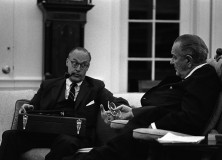CORDS and the Vietnam Experience — Richard W. Stewart, Center of Military History

INTRODUCTION:
After two failed attempts at interagency coordination during the Vietnam War, President Lyndon Johnson decided to intervene directly to improve the management of U.S. support to pacification in South Vietnam. The resulting initiative, known as CORDS (Civil Operations and Revolutionary Support), created an interagency headquarters that streamlined U.S. efforts in support of the South Vietnamese government and the fight against Viet Cong insurgents. The case of CORDS is critical to the Project on National Security Reform (PNSR) as it exemplifies an interagency structure that effectively integrated elements of national power in pursuit of U.S. counter-insurgency, nation-building, and governmental capacity building efforts in South Vietnam.
STRATEGY:
Prior to the inception of CORDS, the U.S. pacification assistance mission in South Vietnam was run by the United States Mission offices in Saigon. The State Department, Central Intelligence Agency (CIA), U.S. Agency for International Development (USAID), U.S. Department of Agriculture (USDA), and the U.S. Information Service (USIS) all were responsible for various aspects of this mission. The military advisory effort was run by Military Assistance Command Vietnam (MACV); however, military assets were outside the direct purview of the embassy. The U.S. Government created CORDS to overcome these organizational and administrative problems and better focus U.S. interagency support behind South Vietnamese efforts at pacification.
INTEGRATED ELEMENTS OF NATIONAL POWER:
CORDS was unique in that it placed nearly all civilian and military interagency assets involved in the pacification struggle under one civilian manager—and then subordinated that individual to the military hierarchy as a Deputy Commander of Military Assistance Command Vietnam. This innovative structure provided the pacification effort nearly unfettered access to enormous military and civilian resources. By centralizing planning and management in one headquarters, and subsequently replicating the identical management structure at every level of the South Vietnamese government (military region, province, and district), CORDS established an effective interagency body. It blended civilian and military personnel and improved U.S. pacification support to all levels of the South Vietnamese government.
EVALUATION:
One variable that explains CORDS’ ultimate success at mitigating interagency tension was the decision to put military commanders in charge of civilians and vice versa. This innovative mixed structure demonstrated to CORDS staff that agencies would reward personnel based on their skills, abilities, and mission performance and not on previous agency loyalty. Furthermore, CORDS was comparatively well-resourced, allowing its elements to accomplish objectives quickly and completely. Finally, CORDS emphasized creating a working relationship with the South Vietnamese to generate more comprehensive pacification plans that would ensure U.S. and Vietnamese military and civilian resources worked together. The Vietnamese pacification planning apparatus would grow in size and capacity as it slowly came to embrace all aspects of its mission.
RESULTS:
CORDS was, on the whole, effective in establishing viable military and civilian aid initiatives in conjunction with the South Vietnamese, efficiently managing those programs and measurably improving the effectiveness of the South Vietnamese security forces in the countryside. However, CORDS’ major, if inherent, weakness was that the organization had to partner with the deeply flawed South Vietnamese government. Although CORDS mobilized and integrated U.S. military and civilian pacification initiatives in support of South Vietnam, it could only achieve a limited success in that, by itself, it could not ensure the viability of an independent South Vietnam.
CONCLUSION:
CORDS assisted the American pacification effort in South Vietnam by reducing interagency bickering, creating a unified pacification effort under a single manager, placing that manager’s headquarters inside the military structure, and thereby allowing it to gain access to vast human, financial and organizational resources in implementing an integrated program at the provincial, district, hamlet, and village level. Despite these achievements, which required the allocation of enormous resources, the effort proved insufficient in itself to sustain the South Vietnamese government against its numerous internal problems and foreign enemies.